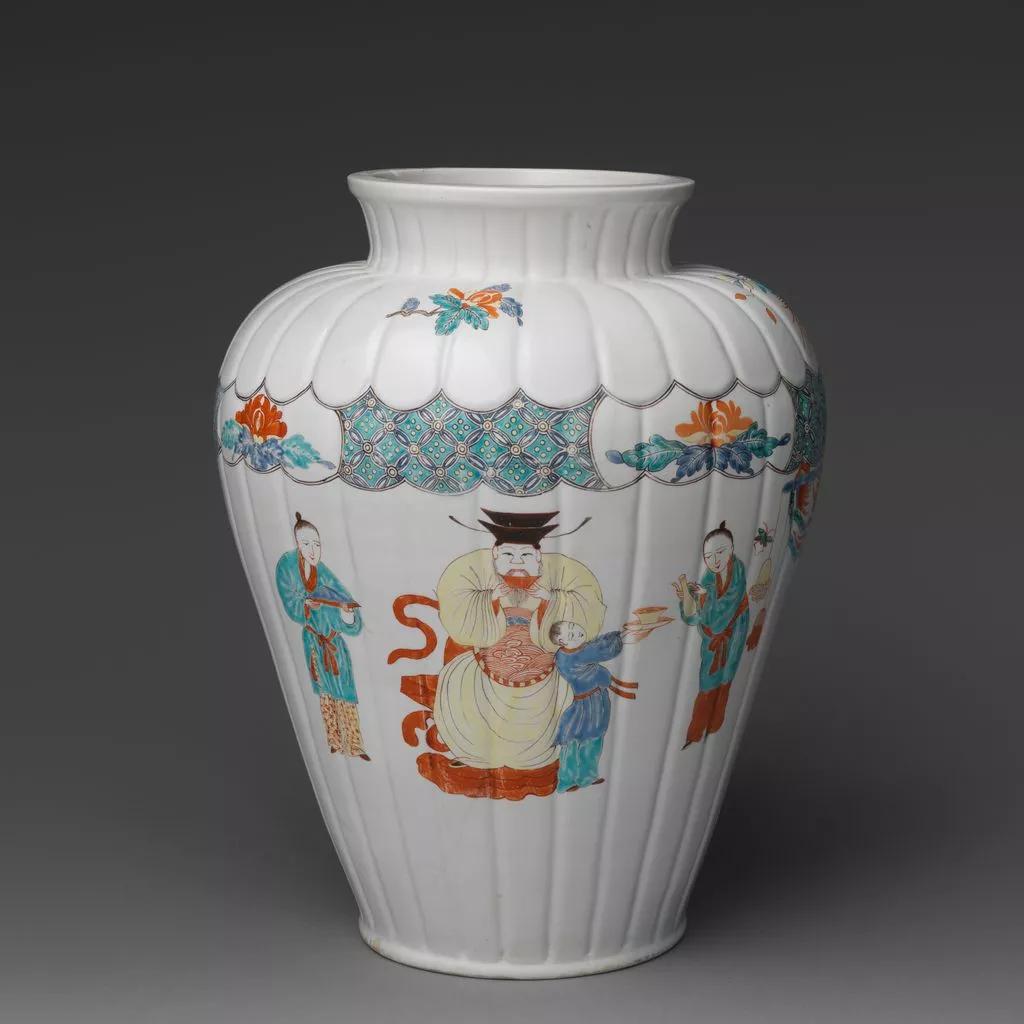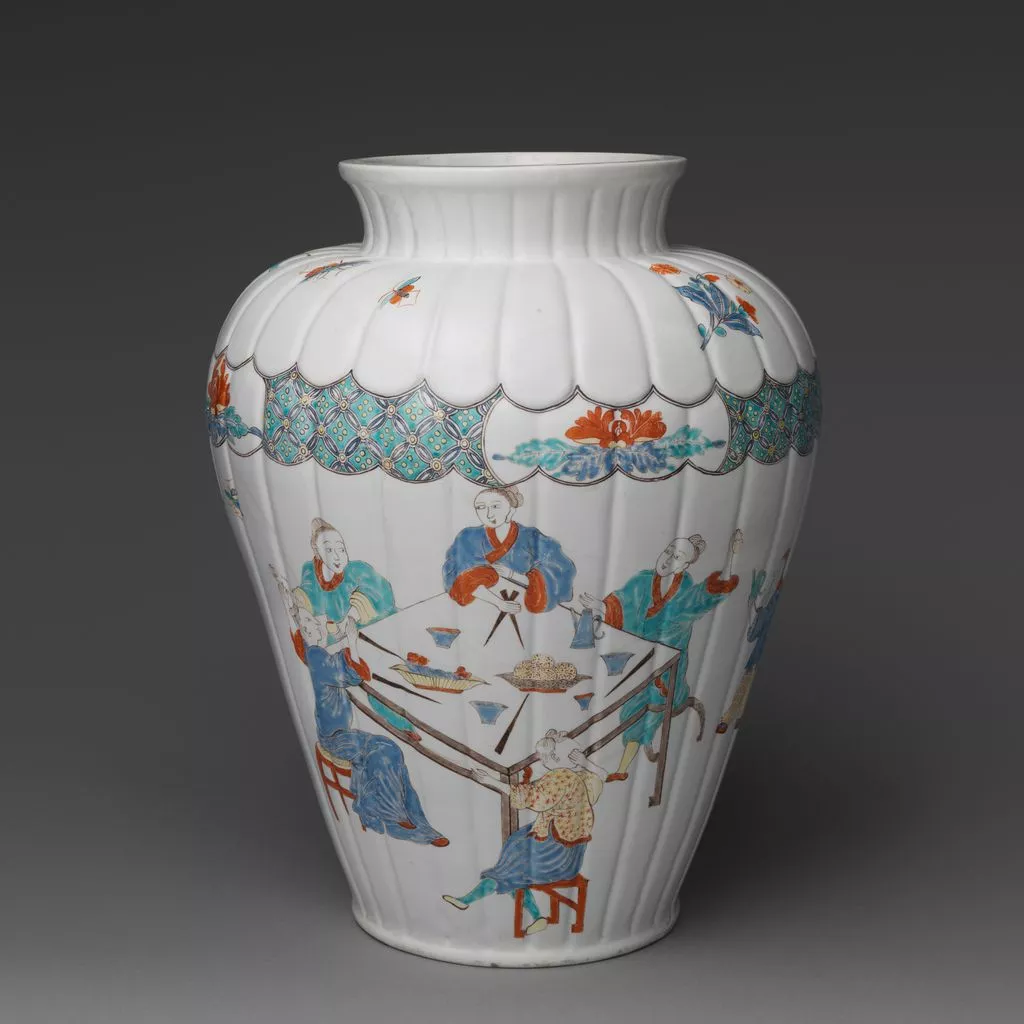Description
This large jar or urn is one of the most ambitious pieces produced by the Chantilly factory, which was founded in 1730 near the Château de Chantilly, the seat of Louis-Henri (1692–1740), duc de Bourbon, seventh prince de Condé. Louis-Henri purchased the land and buildings in 1730 expressly to establish a porcelain factory, and it is likely that the first products of the new enterprise appeared within a year or two after the factory’s founding.[1] Similar to Saint-Cloud, the production was entirely of soft-paste porcelain, because the formula for true or hard-paste porcelain was unknown in France at that time. The early paste developed at the Chantilly factory must have been deemed insufficiently white, since tin was routinely added to the glaze in order to provide a whiter surface on which the enamel decoration would be applied.[2] The presence of tin created a distinctive, opaque, cool white glaze that is a characteristic feature of Chantilly porcelain during the first twenty years of the factory’s history.[3]The Chantilly factory was awarded a letters patent in 1735, which suggests that its production was sufficiently accomplished by that date to merit recognition. The letters, which functioned as a royal privilege, were granted specifically to Cicaire Cirou (French, 1700–1755), the director of the fledgling factory. Relatively little is known of Cirou’s training, but it appears that he worked both at the Saint-Cloud factory and as a porcelain painter in Paris before arriving at Chantilly.[4] The letters patent granted Cirou the right to produce “fine porcelain in all kinds of colors, types, shapes, and sizes imitating the porcelain of Japan”[5] for a period of twenty years. The specification of the factory’s production to imitate Japanese porcelain can be viewed as an acknowledgment of the already established style of the factory’s porcelain, and it may also be regarded as a reflection of Louis-Henri’s interest in Asian porcelain. The duc de Bourbon had a large and notable collection of Asian works of art that he had both inherited and purchased.[6] The collection of Asian ceramics, of which approximately 1,700 are listed in an inventory taken at the time of Louis-Henri’s death in 1740, was particularly strong in Japanese porcelains.[7] The descriptions in the inventory are brief and their accuracy can be questioned, but Japanese porcelains in the Kakiemon style [8] appear to make up the majority of the Japanese holdings.The strong influence of Japanese Kakiemon-style porcelains on Chantilly’s early production reinforces the prevalence of this type of porcelain in Louis-Henri’s collection, and it also suggests that his Japanese pieces were made available to the workers in the factory. While some Japanese forms were copied at Chantilly, it was the motifs of Kakiemon wares that were most influential at the new factory. Decorative schemes taken from Kakiemon porcelains were both copied directly and interpreted by the factory’s painters; however, the primary influence of these Japanese porcelains was the embrace of asymmetry and spare decoration, which are two of the hallmarks of Japanese porcelain in the Kakiemon style.Another source of motifs for the painters at Chantilly was a book of prints published in 1735 by Jean-Antoine Fraisse (French, ca. 1680–1739), entitled Livre de desseins chinois, tirés d’après des originaux de Perse, des Indes, de la Chine et du Japon . . . (Book of Chinese designs taken after the originals from Persia, India, China, and Japan . . .).[9] Fraisse, who lists himself as painter to Louis-Henri on the title page, dedicated the Livre to his employer and cited Louis-Henri’s collection of works of art from Asia as his source of inspiration.[10] The Livre contains a series of prints[11] that provided compositions and decorative motifs for copying by artisans working in a variety of media, and several of Fraisse’s designs were employed by the painters at Chantilly.This jar, which originally would have had a cover, reflects these influences on Chantilly porcelain in the 1730s. Its form, including the fluted bands on the body and shoulder of the vase, is directly derived from a Japanese Kakiemon example,[12] and the painted decoration is inspired by the aesthetics of Kakiemon wares employing the same primary palette of blue, turquoise, red, and yellow, with the addition of brown and black for outlines and decorative details.[13] The scene depicting five figures seated at a table closely copies a composition in Fraisse’s Livre.[14] The composition of the seated male with three attendants found on the opposite side of the jar is not derived from Fraisse,[15] but the fact that the same scene appears on at least one other piece of Chantilly porcelain[16] suggests that a print of this composition must have been available to the painters at the factory.Both scenes depict figures either eating or drinking, but the significance of these two scenes and their pairing on this jar is unclear.[17] While Fraisse’s source for the composition of the seated figure with attendants is unknown, it is likely that it reflects his own invention, though perhaps ultimately rooted in an Asian work of art in Louis-Henri’s collection. All of the figures decorating the jar are clearly intended to represent Asians, and the palette of colors and the sprays of Asian-inspired flowers are inspired directly by Japanese Kakiemon porcelains. However, despite these decorative features and the use of a Japanese form, the Chantilly jar only distantly evokes its Japanese models. The shaped decorative band painted just beneath the shoulder is not typically Japanese in style and the large scale of the figural decoration is uncharacteristic of true Kakiemon porcelains. A further departure from the Japanese models is the awkward fit of the composition of figures around the table and the decorative band above them. Nevertheless, the Museum’s Chantilly jar can be regarded as a major achievement by a nascent factory aiming to produce soft- paste porcelain in the then- fashionable Japanese taste. Chantilly’s production in the Kakiemon style was less concerned with absolute fidelity to Japanese models than it was to reinterpreting and making accessible a certain Japanese aesthetic for a sophisticated European clientele.Footnotes(For key to shortened references see bibliography in Munger, European Porcelain in the Metropolitan Museum of Art. NY: The Metropolitan Museum of Art, 2018)1 For a history of the Chantilly factory, see Dawson 1994, pp. 32–35; Le Duc 1996, pp. 35–55; Garnier-Pelle 2011, pp. 15–24.2 The factory began employing a clear lead glaze without the addition of tin by the early 1750s but did not completely abandon the use of tin glaze for several decades; Jeffrey H. Munger in Munger et al. 1992, pp. 223–24, no. 177. 3 Tin was also added to the glaze at the Villeroy factory; see entries 49–52 in this volume.4 Le Duc 1996, pp. 35–36.5 “porcelaine fine de toutes couleurs, espèces, façens et grandeurs à l’imitation de la porcelaine de Japon.” Dawson 1994, p. 32. 6 See Nelson and Impey 1994. 7 The inventory is partially transcribed in “Inventaire du duc de Bourbon” 2011. 8 For an explanation of the term “Kakiemon,” see Impey 1990; Impey 2002, pp. 25–29.9 The full title is Livre de desseins chinois, tirés d’après des originaux de Perse, des Indes, de la Chine et du Japon, dessinés et gravés en taille-douce par le sr Fraisse, peintre de S.A.S. Monseigner le Duc, dedié a Son Altesse Serenissime (Paris: Ph. Nic. Lottin, 1735).10 Garnier-Pelle 2011, p. 10.11 Various versions of the Livre survive, each slightly different in terms of the number of prints and the order in which they appear; see S. Miller 1996.12 See Finaz de Villaine and Garnier-Pelle 2011, p. 24, no. 28. This Japanese jar is now in the Musée Condé, Chantilly, as is a Chantilly copy of it (Finaz de Villaine and Garnier-Pelle 2011, p. 25, no. 29), but it is not certain if both were in the collections of Louis-Henri in the eighteenth century. There are similar Japanese examples at the Ashmolean Museum, Oxford (1985.49), and the Birmingham Museum of Art, Ala. (1980.431).13 Overglaze brown enamel was used infrequently on Japanese Kakiemon-style porcelain; see Impey 1990, p. 140.14 Garnier-Pelle 2011, ill. p. 20.15 This seated figure does not appear in either the copy of the Livre in The Metropolitan Museum of Art (40.38) or Fraisse 2011 (facsimile reprint of the 1735 edition), but it is possible that it is included in one of the other versions of the Livre, as no two versions are identical.16 A bottle cooler (seau à bouteille); Finaz de Villaine and Garnier-Pelle 2011, p. 27, no. 34. 17 The two scenes are also paired on a Chantilly jar with similar, though wider, fluted decoration (Le Duc 1996, ill. pp. 116–17), and the composition of the figures around a table is paired with a different scene, also taken from Fraisse’s Livre, on a Chantilly jar of the same model (Christie’s, London, sale cat., February 24, 1997, no. 190).








